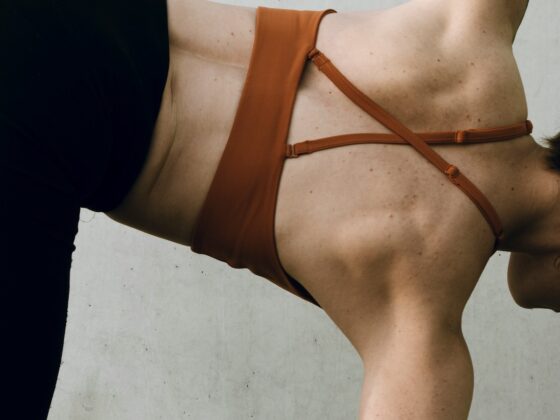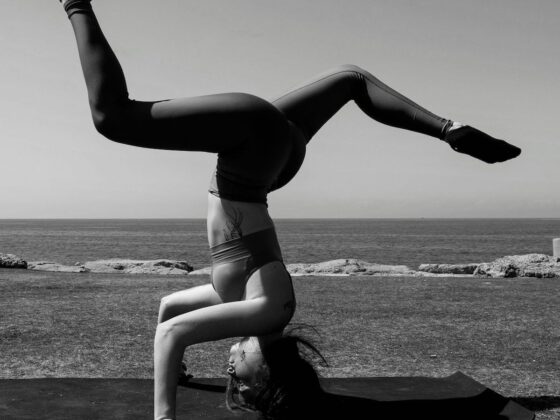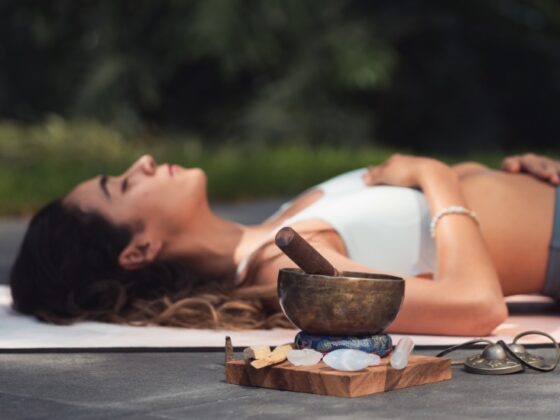If you’re a purist, you may wonder whether a yoga mat is necessary at all. After all, these mats were unheard of centuries ago, when yoga practitioners in ancient India developed this art and science.
They practiced asanas (poses) on natural floor surfaces such as grass, mud, sand, or straw mats. Many modern yoga mats are made from synthetic materials such as PVC, which may go against the principles of environmentally conscious yoga practitioners.
Strictly speaking, yoga mats are not essential for practicing and performing yoga. However, they are an important accessory and have become a key component at every stage of your yoga journey.
Why Are Yoga Mats Important?
The main reason to use a yoga mat is that it’s specifically designed for this practice. It differs from exercise mats or normal floor rugs because it offers a stronger grip on the floor, no matter what surface you’re working on.
A yoga mat also helps protect your body from dust or dirt on the floor and ensures you don’t come into contact with harmful substances. If you practice in a gym, it’s easy to imagine how sweaty and unhygienic the floors can get.
When performing complex poses—especially those that involve your back, wrists, or feet—a mat provides greater comfort and stability. Your joints are better protected, and you reduce the risk of sprains, strains, slippage, or muscle cramps.
Some yoga practitioners recommend having a barrier between your body and the ground, believing the Earth’s magnetic field could drain your energy. A yoga mat serves as that barrier.
Lastly, yoga mats can help maintain a stable temperature during practice.
How to Choose the Best Yoga Mat?
If you’re a beginner contemplating a yoga mat purchase, you may feel confused and overwhelmed by the sheer number of choices available.
One of my favourite type of mats are the Rest and Digest yoga mats however there are a number on the market. If you do not like my suggestion hopefully by the end of this article, you should be well on your way to be able to pick one that works for you.
Material
This is often a personal choice. You can choose regular PVC mats, but be sure to pick a good-quality one.
Cheaper mats might release toxic chemicals when they come into contact with body heat or sweat, and many have an unpleasant odor. Other available materials include cotton, jute, cork, rubber, or TPE.
Thickness
When choosing a yoga mat, make sure it’s at least 3–5 mm thick. If you suffer from joint pain or are on the heavier side, opt for a thicker mat.
However, mats thicker than 6 mm can be less stable. Rougher textures provide better grip, while smoother mats may feel more comfortable—it’s entirely up to you.
Grip and Texture
A mat’s grip is crucial for preventing slips during practice. Textured surfaces enhance traction, particularly important for hot yoga or sweaty practices. Some mats feature raised patterns or grooves to improve grip.
Natural rubber and cork mats often provide excellent grip, even when wet. PVC mats may become slippery with moisture but can be improved with use or by using a yoga towel.
Non-slip surfaces are essential for safety and confidence in poses, allowing practitioners to focus on their practice without worrying about sliding.
Size
Generally, a standard off-the-shelf yoga mat measures 68 × 24 inches, which can accommodate someone of average height and weight. If you’re taller or wider, you should select a mat that meets your specific requirements.
A larger mat also allows practitioners of average size to explore different postures without the risk of stepping off the mat. (Quick tip: If you’re part of a large group, bigger mats give you more personal space!)
Weight
It’s important to have a mat that’s easy to carry and lightweight if you commute to classes.
Many practitioners keep one mat at home and another for classes. If you have limited space at home, pick a mat that can be neatly stowed away.
Support and Stability
A yoga mat’s support and stability are influenced by its material, thickness, and texture. Firmer mats generally offer better stability for standing poses and inversions.
Mats with good rebound properties help absorb impact and provide cushioning for joints. Some mats feature alignment lines to assist with proper positioning in poses.
The mat’s ability to lay flat without curling at the edges contributes to overall stability. A stable mat allows practitioners to move confidently through their sequences without distraction.
Yoga Style
Although the foundation of yoga practice is the same across many styles, some styles—such as Ashtanga or Vinyasa—involve faster movements, so you’ll need a mat with superior grip.
For styles like power yoga or Bikram yoga, where you tend to sweat a lot, choose a mat that absorbs sweat quickly. If you practice longer sessions of meditation, pick a comfortable mat that supports prolonged sitting.
Mats for Hot Yoga
Hot yoga demands mats with excellent grip and moisture-wicking properties. Look for mats made from natural rubber or specialized non-slip materials. These mats should have a textured surface to prevent slipping in sweaty conditions.
Manduka offers mats designed specifically for hot yoga, featuring closed-cell technology that prevents sweat absorption. Some practitioners prefer using a yoga towel over their mat for added traction.
Thickness is less critical for hot yoga, as the focus is on stability. A mat thickness of 3-4mm is typically sufficient. Durability is essential, as hot yoga mats endure frequent cleaning due to sweat exposure.
Mats for Restorative Yoga
Restorative yoga emphasizes comfort and support during long-held poses. Mats for this practice should be thicker, typically 6mm or more, to provide cushioning for joints and bony areas.
Materials like TPE (Thermoplastic Elastomer) or memory foam offer excellent comfort and support. These mats often have a smooth surface, as grip is less crucial in restorative practices.
Look for mats with alignment markers to assist with proper positioning in restorative poses. Some mats come with built-in bolster-like features for added support during practice.
Mats for Ashtanga Yoga
Ashtanga yoga involves dynamic movements and requires a mat with a balance of grip and mobility. Natural rubber mats or those with a polyurethane top layer work well for this practice.
Thickness should be moderate, around 4-5mm, to provide enough cushioning without compromising stability. The mat surface should offer grip but allow for smooth transitions between poses.
Durability is key for Ashtanga mats, as the practice involves frequent use. Look for mats with reinforced edges to prevent fraying. Some practitioners prefer mats with a slightly rough texture to enhance grip during challenging poses.
Mats for Travel Yoga
Travel yoga mats prioritize portability without sacrificing functionality. These mats are typically thinner, around 1-2mm, and lightweight. Materials like natural rubber or eco-friendly PVC blends offer a good balance of grip and durability.
Foldable mats are ideal for travel, as they take up less space in luggage. Some travel mats come with carrying straps or bags for easy transport. Despite their thinness, quality travel mats should still provide adequate grip on various surfaces.
Consider mats with antimicrobial properties for hygiene during travel. Quick-drying materials are beneficial for practitioners on the go. Some travel mats feature printed alignment guides to maintain proper form in unfamiliar practice spaces.
Longevity of Different Mat Types
Rubber mats offer excellent durability and can last 2-3 years with regular use. They resist wear and tear but may degrade faster if exposed to sunlight. Cork mats provide natural antimicrobial properties and can endure 1-2 years of frequent practice. Their texture improves with use, developing a unique patina.
PVC yoga mats boast the longest lifespan, often lasting 5-10 years. They withstand intense use and are easy to clean. However, PVC is not biodegradable, raising environmental concerns.
Natural fiber mats, such as jute or cotton, typically last 1-2 years. While eco-friendly, they require more frequent replacement.
Natural and Eco-Friendly Materials
Natural rubber mats offer excellent grip and durability. They’re biodegradable and derived from renewable sources. Cork yoga mats provide antimicrobial properties and improve traction when wet. They’re harvested sustainably without harming trees.
Jute mats blend natural fibers with eco-friendly polymers for a sturdy, textured surface. TPE (Thermoplastic Elastomer) mats are non-toxic and recyclable alternatives to traditional PVC.
Recyclable and Biodegradable Mats
Biodegradable mats break down naturally at the end of their lifecycle. Natural rubber and cork mats typically decompose within 1-5 years in proper conditions.
Recyclable mats can be repurposed into new products. Some brands offer take-back programs, allowing users to return old mats for recycling. TPE mats are often fully recyclable.
Look for mats free from harmful chemicals like PVC, phthalates, and heavy metals. These eco-friendly options promote both personal and environmental health.
Price Range
Yoga mats come in a wide price range, from budget-friendly options to premium selections. Basic mats typically cost between $20-$50, offering adequate support for beginners. Mid-range mats, priced $50-$100, often provide enhanced durability and grip.
Premium yoga mats, such as those from Manduka or Liforme, can exceed $100. These high-quality mats offer superior traction, cushioning, and longevity. While expensive, they may prove cost-effective for dedicated practitioners due to their extended lifespan.
Consider your practice frequency and style when determining your budget. Occasional practitioners might find a mid-range mat sufficient, while daily yogis may benefit from investing in a premium option.
Comparing Brands and Models
Research is key when comparing yoga mat brands and models. Look for reviews from experienced yogis and reputable fitness publications. Pay attention to feedback on grip, durability, and comfort.
- Consider the following aspects when evaluating different mats:
- Warranty and customer support
- Material composition
- Thickness and weight
- Environmental impact
FAQ
What are the benefits of different yoga mat materials?
Different materials offer unique advantages. PVC mats provide excellent grip and durability. Natural rubber mats offer eco-friendly options with good cushioning. Cork mats are antimicrobial and moisture-absorbing. TPE mats balance comfort and environmental consciousness.
How does mat thickness impact a yoga practice, and what thickness is recommended for beginners?
Mat thickness affects stability and cushioning. Thinner mats (1-2mm) offer better balance for standing poses. Thicker mats (4-6mm) provide more cushioning for joint support. Beginners often benefit from a 3-4mm mat, balancing stability and comfort.
What features should a beginner look for when selecting their first yoga mat?
Beginners should prioritize grip, durability, and moderate thickness. Look for non-slip surfaces to prevent slipping during poses. Choose a mat with easy-to-clean properties. Consider a mat with alignment markings to help with proper positioning.
Can you explain the differences between a 4mm and a 6mm yoga mat, and which might be better for various practices?
A 4mm mat offers a balance of stability and cushioning, suitable for most practices. It’s ideal for vinyasa or power yoga. A 6mm mat provides extra cushioning, beneficial for restorative yoga or practices with more floor work. The thicker mat may slightly reduce stability in standing poses.
Which yoga mats are preferred by professional yoga instructors?
Professional instructors often prefer mats with excellent grip and durability. Brands like Manduka, Jade, and Lululemon are popular choices. Many professionals opt for mats with eco-friendly materials and longer lifespans. Some instructors prefer thinner mats for enhanced stability during demonstrations.



